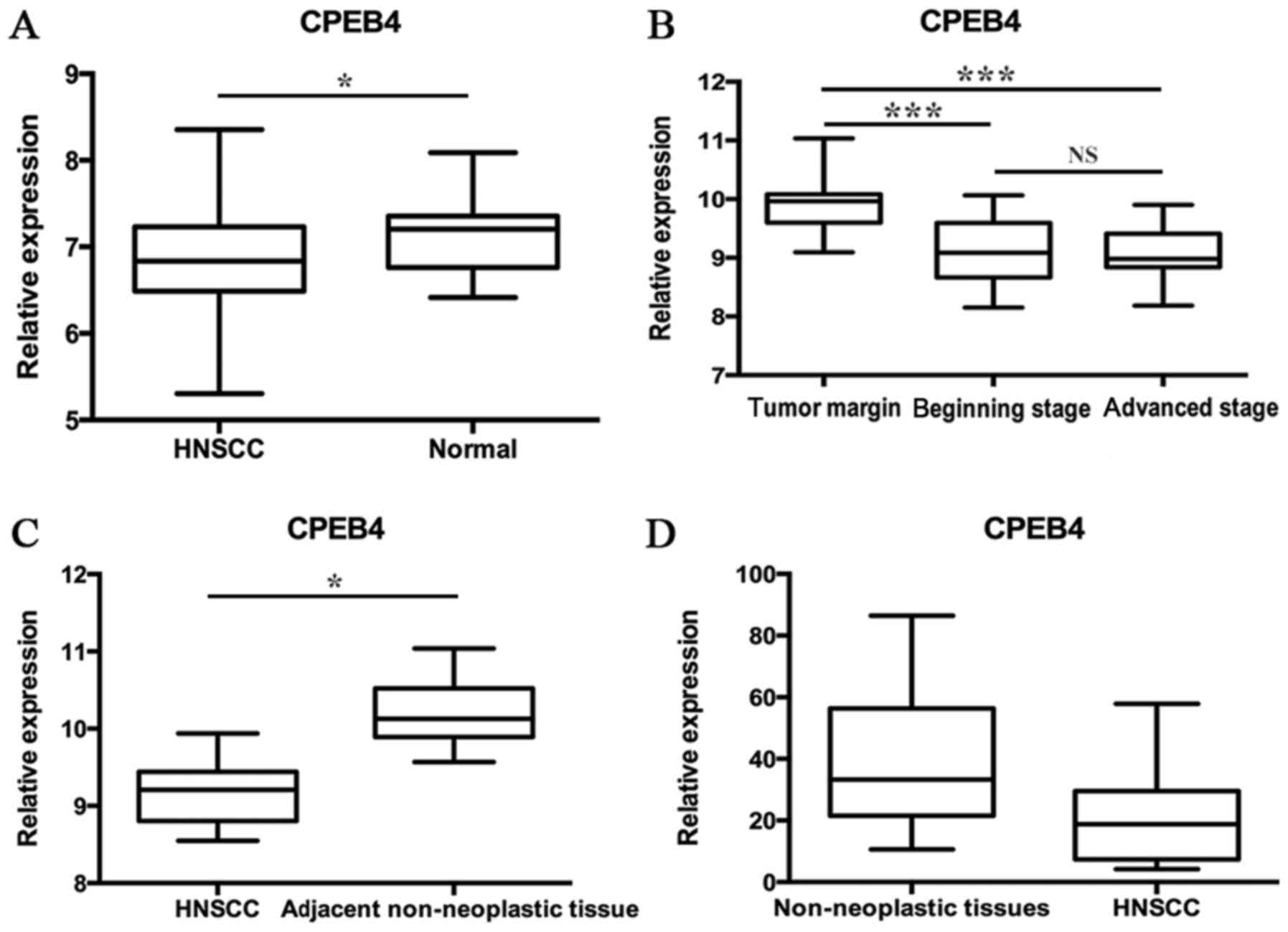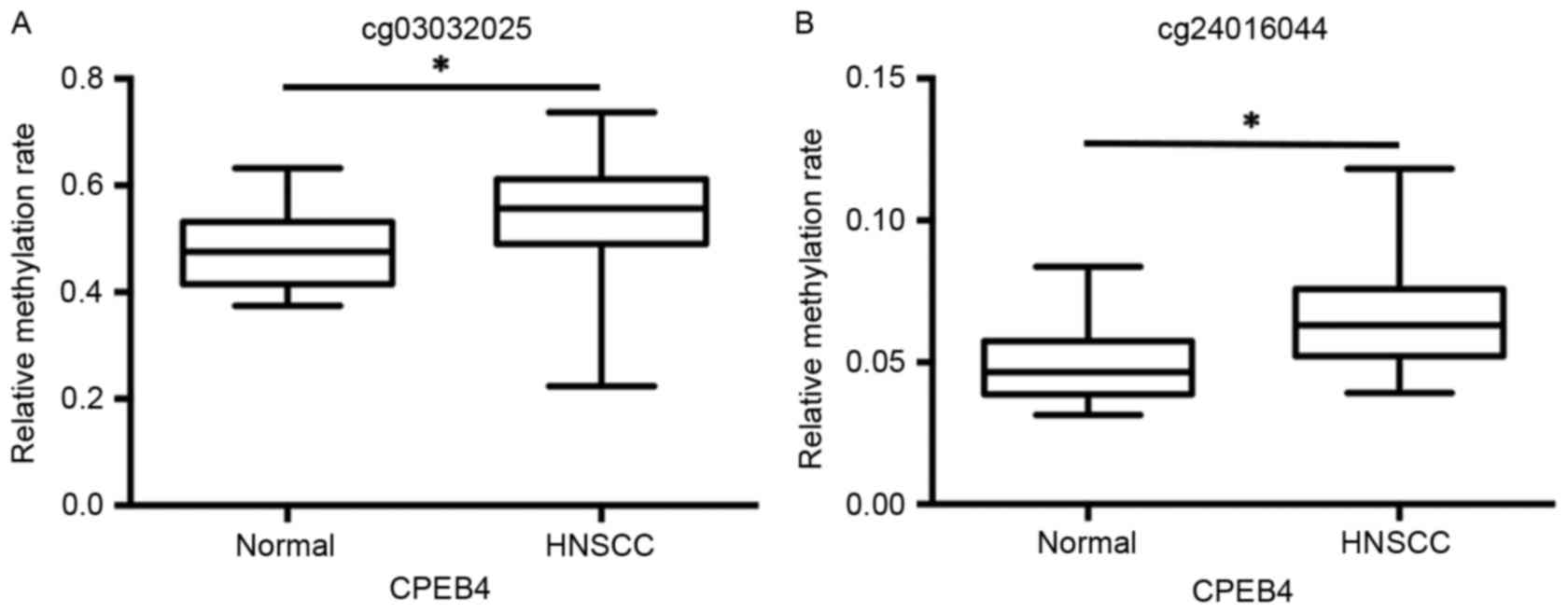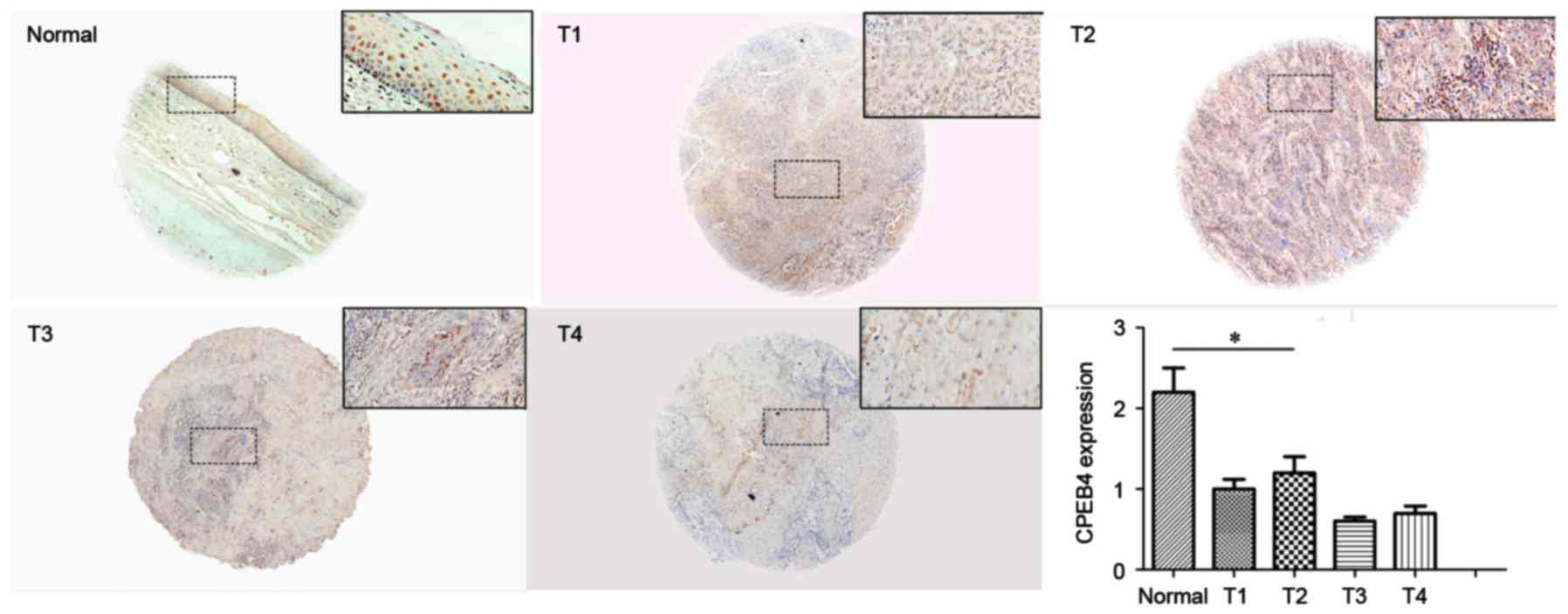|
1
|
Howren MB, Christensen AJ, Karnell LH and
Funk GF: Psychological factors associated with head and neck cancer
treatment and survivorship: Evidence and opportunities for
behavioral medicine. J Consult Clin Psychol. 81:299–317. 2013.
View Article : Google Scholar : PubMed/NCBI
|
|
2
|
Khan Z, Khan AA, Prasad GB, Khan N, Tiwari
RP and Bisen PS: Growth inhibition and chemo-radiosensitization of
head and neck squamous cell carcinoma (HNSCC) by survivin-siRNA
lentivirus. Radiother Oncol. 118:359–368. 2016. View Article : Google Scholar : PubMed/NCBI
|
|
3
|
Döbrossy L: Epidemiology of head and neck
cancer: Magnitude of the problem. Cancer Metastasis Rev. 24:9–17.
2005. View Article : Google Scholar : PubMed/NCBI
|
|
4
|
Boeckx C, Op de Beeck K, Wouters A,
Deschoolmeester V, Limame R, Zwaenepoel K, Specenier P, Pauwels P,
Vermorken JB, Peeters M, et al: Overcoming cetuximab resistance in
HNSCC: The role of AURKB and DUSP proteins. Cancer Lett.
354:365–377. 2014. View Article : Google Scholar : PubMed/NCBI
|
|
5
|
Molinolo AA, Amornphimoltham P, Squarize
CH, Castilho RM, Patel V and Gutkind JS: Dysregulated molecular
networks in head and neck carcinogenesis. Oral Oncol. 45:324–334.
2009. View Article : Google Scholar : PubMed/NCBI
|
|
6
|
Kulasinghe A, Perry C, Jovanovic L, Nelson
C and Punyadeera C: Circulating tumour cells in metastatic head and
neck cancers. Int J Cancer. 136:2515–2523. 2015. View Article : Google Scholar : PubMed/NCBI
|
|
7
|
Thomas GR, Nadiminti H and Regalado J:
Molecular predictors of clinical outcome in patients with head and
neck squamous cell carcinoma. Int J Exp Pathol. 86:347–363. 2005.
View Article : Google Scholar : PubMed/NCBI
|
|
8
|
Burns DM, D'Ambrogio A, Nottrott S and
Richter JD: CPEB and two poly(A) polymerases control miR-122
stability and p53 mRNA translation. Nature. 473:105–108. 2011.
View Article : Google Scholar : PubMed/NCBI
|
|
9
|
Mendez R and Richter JD: Translational
control by CPEB: A means to the end. Nat Rev Mol Cell Biol.
2:521–529. 2001. View
Article : Google Scholar : PubMed/NCBI
|
|
10
|
Radford HE, Meijer HA and de Moor CH:
Translational control by cytoplasmic polyadenylation in Xenopus
oocytes. Biochim Biophys Acta. 1779:217–229. 2008. View Article : Google Scholar : PubMed/NCBI
|
|
11
|
Fernández-Miranda G and Méndez R: The
CPEB-family of proteins, translational control in senescence and
cancer. Ageing Res Rev. 11:460–472. 2012. View Article : Google Scholar : PubMed/NCBI
|
|
12
|
Hake LE, Mendez R and Richter JD:
Specificity of RNA binding by CPEB: Requirement for RNA recognition
motifs and a novel zinc finger. Mol Cell Biol. 18:685–693. 1998.
View Article : Google Scholar : PubMed/NCBI
|
|
13
|
Hake LE and Richter JD: CPEB is a
specificity factor that mediates cytoplasmic polyadenylation during
xenopus oocyte maturation. Cell. 79:617–627. 1994. View Article : Google Scholar : PubMed/NCBI
|
|
14
|
Theis M, Si K and Kandel ER: Two
previously undescribed members of the mouse CPEB family of genes
and their inducible expression in the principal cell layers of the
hippocampus. Proc Natl Acad Sci USA. 100:pp. 9602–9607. 2003;
View Article : Google Scholar : PubMed/NCBI
|
|
15
|
Huang YS, Kan MC, Lin CL and Richter JD:
CPEB3 and CPEB4 in neurons: Analysis of RNA-binding specificity and
translational control of AMPA receptor GluR2 mRNA. EMBO J.
25:4865–4876. 2006. View Article : Google Scholar : PubMed/NCBI
|
|
16
|
Tay J and Richter JD: Germ cell
differentiation and synaptonemal complex formation are disrupted in
CPEB knockout mice. Dev Cell. 1:201–213. 2001. View Article : Google Scholar : PubMed/NCBI
|
|
17
|
Hafer N, Xu S, Bhat KM and Schedl P: The
drosophila CPEB protein Orb2 has a novel expression pattern and is
important for asymmetric cell division and nervous system function.
Genetics. 189:907–921. 2011. View Article : Google Scholar : PubMed/NCBI
|
|
18
|
Wang XP and Cooper NG: Characterization of
the transcripts and protein isoforms for cytoplasmic
polyadenylation element binding protein-3 (CPEB3) in the mouse
retina. BMC Mol Biol. 10:1092009. View Article : Google Scholar : PubMed/NCBI
|
|
19
|
Groisman I, Ivshina M, Marin V, Kennedy
NJ, Davis RJ and Richter JD: Control of cellular senescence by
CPEB. Genes Dev. 20:2701–2712. 2006. View Article : Google Scholar : PubMed/NCBI
|
|
20
|
Hansen CN, Ketabi Z, Rosenstierne MW,
Palle C, Boesen HC and Norrild B: Expression of CPEB, GAPDH and
U6snRNA in cervical and ovarian tissue during cancer development.
APMIS. 117:53–59. 2009. View Article : Google Scholar : PubMed/NCBI
|
|
21
|
Ortiz-Zapater E, Pineda D, Martínez-Bosch
N, Fernández-Miranda G, Iglesias M, Alameda F, Moreno M, Eliscovich
C, Eyras E, Real FX, et al: Key contribution of CPEB4-mediated
translational control to cancer progression. Nat Med. 18:83–90.
2011. View
Article : Google Scholar : PubMed/NCBI
|
|
22
|
Sun HT, Wen X, Han T, Liu ZH, Li SB, Wang
JG and Liu XP: Expression of CPEB4 in invasive ductal breast
carcinoma and its prognostic significance. Onco Targets Ther.
8:3499–3506. 2015.PubMed/NCBI
|
|
23
|
Barrett T, Wilhite SE, Ledoux P,
Evangelista C, Kim IF, Tomashevsky M, Marshall KA, Phillippy KH,
Sherman PM, Holko M, et al: NCBI GEO: Archive for functional
genomics data sets-update. Nucleic Acids Res. 41(Database Issue):
D991–D995. 2013.PubMed/NCBI
|
|
24
|
Sun W, Gaykalova DA, Ochs MF, Mambo E,
Arnaoutakis D, Liu Y, Loyo M, Agrawal N, Howard J, Li R, et al:
Activation of the NOTCH pathway in head and neck cancer. Cancer
Res. 74:1091–1104. 2014. View Article : Google Scholar : PubMed/NCBI
|
|
25
|
de Barros E Lima, Bueno R, Ramão A,
Pinheiro DG, Alves CP, Kannen V, Jungbluth AA, de Araújo LF, Muys
BR, Fonseca AS, Plaça JR, et al: HOX genes: Potential candidates
for the progression of laryngeal squamous cell carcinoma. Tumour
Biol. 37:15087–15096. 2016. View Article : Google Scholar : PubMed/NCBI
|
|
26
|
Lobert S, Graichen ME, Hamilton RD, Pitman
KT, Garrett MR, Hicks C and Koganti T: Prognostic biomarkers for
HNSCC using quantitative real-time PCR and microarray analysis:
β-tubulin isotypes and the p53 interactome. Cytoskeleton (Hoboken).
71:628–637. 2014. View
Article : Google Scholar : PubMed/NCBI
|
|
27
|
Regla-Nava JA, Nieto-Torres JL,
Jimenez-Guardeño JM, Fernandez-Delgado R, Fett C, Castaño-Rodríguez
C, Perlman S, Enjuanes L and DeDiego ML: Severe acute respiratory
syndrome coronaviruses with mutations in the E protein are
attenuated and promising vaccine candidates. J Virol. 89:3870–3887.
2015. View Article : Google Scholar : PubMed/NCBI
|
|
28
|
Walter V, Yin X, Wilkerson MD, Cabanski
CR, Zhao N, Du Y, Ang MK, Hayward MC, Salazar AH, Hoadley KA, et
al: Molecular subtypes in head and neck cancer exhibit distinct
patterns of chromosomal gain and loss of canonical cancer genes.
PLoS One. 8:e568232013. View Article : Google Scholar : PubMed/NCBI
|
|
29
|
Poage GM, Houseman EA, Christensen BC,
Butler RA, Avissar-Whiting M, McClean MD, Waterboer T, Pawlita M,
Marsit CJ and Kelsey KT: Global hypomethylation identifies Loci
targeted for hypermethylation in head and neck cancer. Clin Cancer
Res. 17:3579–3589. 2011. View Article : Google Scholar : PubMed/NCBI
|
|
30
|
Kan MC, Oruganty-Das A, Cooper-Morgan A,
Jin G, Swanger SA, Bassell GJ, Florman H, van Leyen K and Richter
JD: CPEB4 is a cell survival protein retained in the nucleus upon
ischemia or endoplasmic reticulum calcium depletion. Mol Cell Biol.
30:5658–5671. 2010. View Article : Google Scholar : PubMed/NCBI
|
|
31
|
Zhong X, Xiao Y, Chen C, Wei X, Hu C, Ling
X and Liu X: MicroRNA-203-mediated posttranscriptional deregulation
of CPEB4 contributes to colorectal cancer progression. Biochem
Biophys Res Commun. 466:206–213. 2015. View Article : Google Scholar : PubMed/NCBI
|
|
32
|
Chen W, Hu Z, Li XZ, Li JL, Xu XK, Li HG,
Liu Y, Liu BH, Jia WH and Li FC: CPEB4 interacts with Vimentin and
involves in progressive features and poor prognosis of patients
with astrocytic tumors. Tumour Biol. 37:5075–5087. 2016. View Article : Google Scholar : PubMed/NCBI
|
|
33
|
Hu W, Yang Y, Xi S, Sai K, Su D, Zhang X,
Lin S and Zeng J: Expression of CPEB4 in human glioma and its
correlations with prognosis. Medicine (Baltimore). 94:e9792015.
View Article : Google Scholar : PubMed/NCBI
|
|
34
|
Xu H and Liu B: CPEB4 is a candidate
biomarker for defining metastatic cancers and directing
personalized therapies. Med Hypotheses. 81:875–877. 2013.
View Article : Google Scholar : PubMed/NCBI
|
|
35
|
Tian Q, Liang L, Ding J, Zha R, Shi H,
Wang Q, Huang S, Guo W, Ge C, Chen T, et al: MicroRNA-550a acts as
a pro-metastatic gene and directly targets cytoplasmic
polyadenylation element-binding protein 4 in hepatocellular
carcinoma. PLoS One. 7:e489582012. View Article : Google Scholar : PubMed/NCBI
|
|
36
|
Huang W, Li H and Luo R: The microRNA-1246
promotes metastasis in non-small cell lung cancer by targeting
cytoplasmic polyadenylation element-binding protein 4. Diagn
Pathol. 10:1272015. View Article : Google Scholar : PubMed/NCBI
|
|
37
|
D'Ambrogio A, Nagaoka K and Richter JD:
Translational control of cell growth and malignancy by the CPEBs.
Nat Rev Cancer. 13:283–290. 2013. View Article : Google Scholar : PubMed/NCBI
|
















